sensor BMW 3 SERIES SEDAN 2013 F30 User Guide
[x] Cancel search | Manufacturer: BMW, Model Year: 2013, Model line: 3 SERIES SEDAN, Model: BMW 3 SERIES SEDAN 2013 F30Pages: 248, PDF Size: 5.21 MB
Page 103 of 248
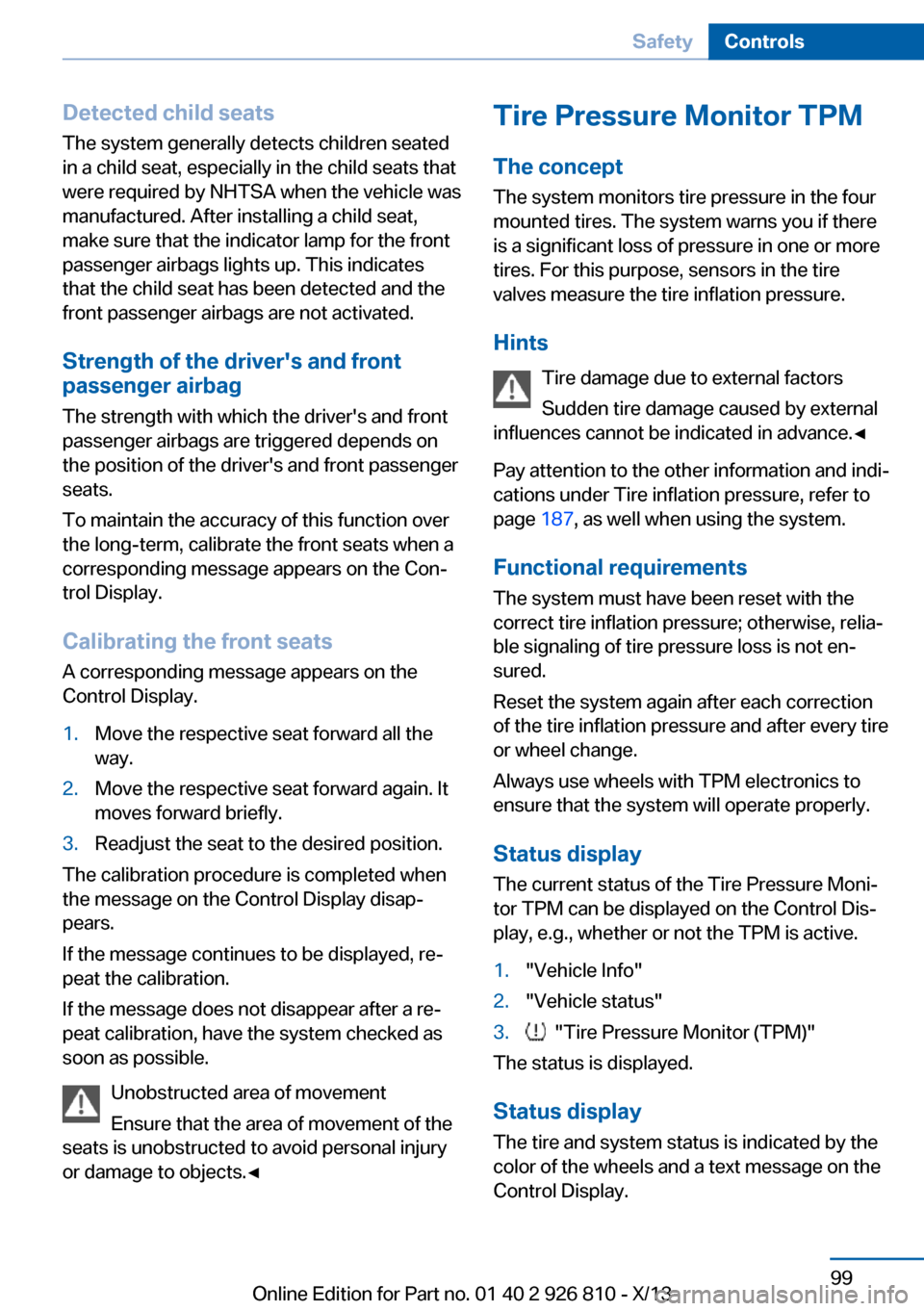
Detected child seatsThe system generally detects children seated
in a child seat, especially in the child seats that
were required by NHTSA when the vehicle was
manufactured. After installing a child seat,
make sure that the indicator lamp for the front
passenger airbags lights up. This indicates that the child seat has been detected and the
front passenger airbags are not activated.
Strength of the driver's and front
passenger airbag
The strength with which the driver's and front
passenger airbags are triggered depends on
the position of the driver's and front passenger
seats.
To maintain the accuracy of this function over
the long-term, calibrate the front seats when a
corresponding message appears on the Con‚Äź
trol Display.
Calibrating the front seats A corresponding message appears on the
Control Display.1.Move the respective seat forward all the
way.2.Move the respective seat forward again. It
moves forward briefly.3.Readjust the seat to the desired position.
The calibration procedure is completed when
the message on the Control Display disap‚Äź
pears.
If the message continues to be displayed, re‚Äź
peat the calibration.
If the message does not disappear after a re‚Äź
peat calibration, have the system checked as
soon as possible.
Unobstructed area of movement
Ensure that the area of movement of the
seats is unobstructed to avoid personal injury
or damage to objects.‚óÄ
Tire Pressure Monitor TPM
The concept The system monitors tire pressure in the four
mounted tires. The system warns you if there
is a significant loss of pressure in one or more
tires. For this purpose, sensors in the tire
valves measure the tire inflation pressure.
Hints Tire damage due to external factors
Sudden tire damage caused by external
influences cannot be indicated in advance.‚óÄ
Pay attention to the other information and indi‚Äź
cations under Tire inflation pressure, refer to
page 187, as well when using the system.
Functional requirements
The system must have been reset with the
correct tire inflation pressure; otherwise, relia‚Äź
ble signaling of tire pressure loss is not en‚Äź
sured.
Reset the system again after each correction
of the tire inflation pressure and after every tire
or wheel change.
Always use wheels with TPM electronics to
ensure that the system will operate properly.
Status display The current status of the Tire Pressure Moni‚Äź
tor TPM can be displayed on the Control Dis‚Äź
play, e.g., whether or not the TPM is active.1."Vehicle Info"2."Vehicle status"3. "Tire Pressure Monitor (TPM)"
The status is displayed.
Status display The tire and system status is indicated by the
color of the wheels and a text message on the
Control Display.
Seite 99SafetyControls99
Online Edition for Part no. 01 40 2 926 810 - X/13
Page 112 of 248
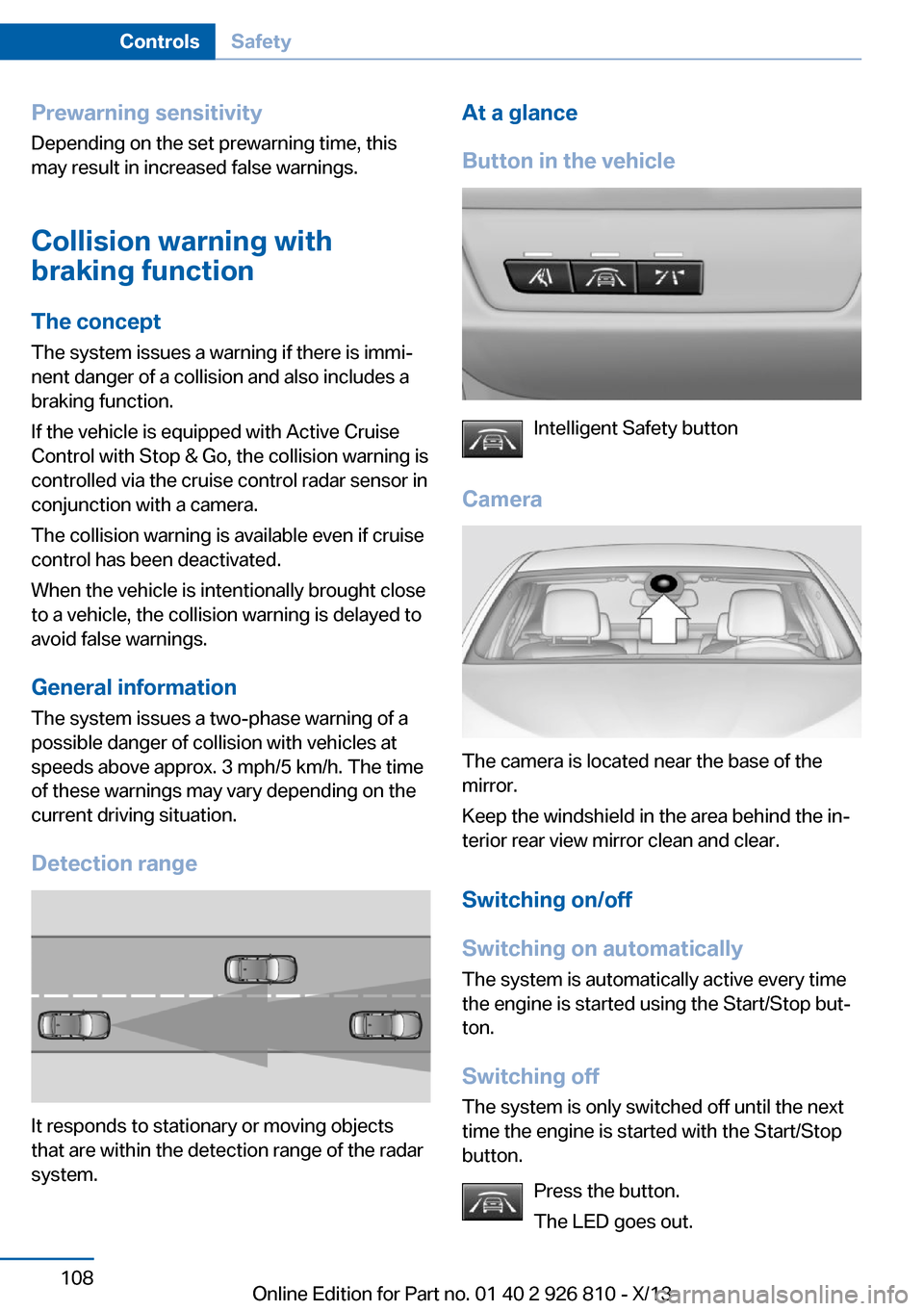
Prewarning sensitivityDepending on the set prewarning time, this
may result in increased false warnings.
Collision warning withbraking function
The concept
The system issues a warning if there is immi‚Äź
nent danger of a collision and also includes a
braking function.
If the vehicle is equipped with Active Cruise
Control with Stop & Go, the collision warning is
controlled via the cruise control radar sensor in
conjunction with a camera.
The collision warning is available even if cruise
control has been deactivated.
When the vehicle is intentionally brought close
to a vehicle, the collision warning is delayed to
avoid false warnings.
General information The system issues a two-phase warning of a
possible danger of collision with vehicles at
speeds above approx. 3 mph/5 km/h. The time
of these warnings may vary depending on the
current driving situation.
Detection range
It responds to stationary or moving objects
that are within the detection range of the radar
system.
At a glance
Button in the vehicle
Intelligent Safety button
Camera
The camera is located near the base of the
mirror.
Keep the windshield in the area behind the in‚Äź
terior rear view mirror clean and clear.
Switching on/off
Switching on automatically The system is automatically active every time
the engine is started using the Start/Stop but‚Äź
ton.
Switching off The system is only switched off until the next
time the engine is started with the Start/Stop
button.
Press the button.
The LED goes out.
Seite 108ControlsSafety108
Online Edition for Part no. 01 40 2 926 810 - X/13
Page 118 of 248
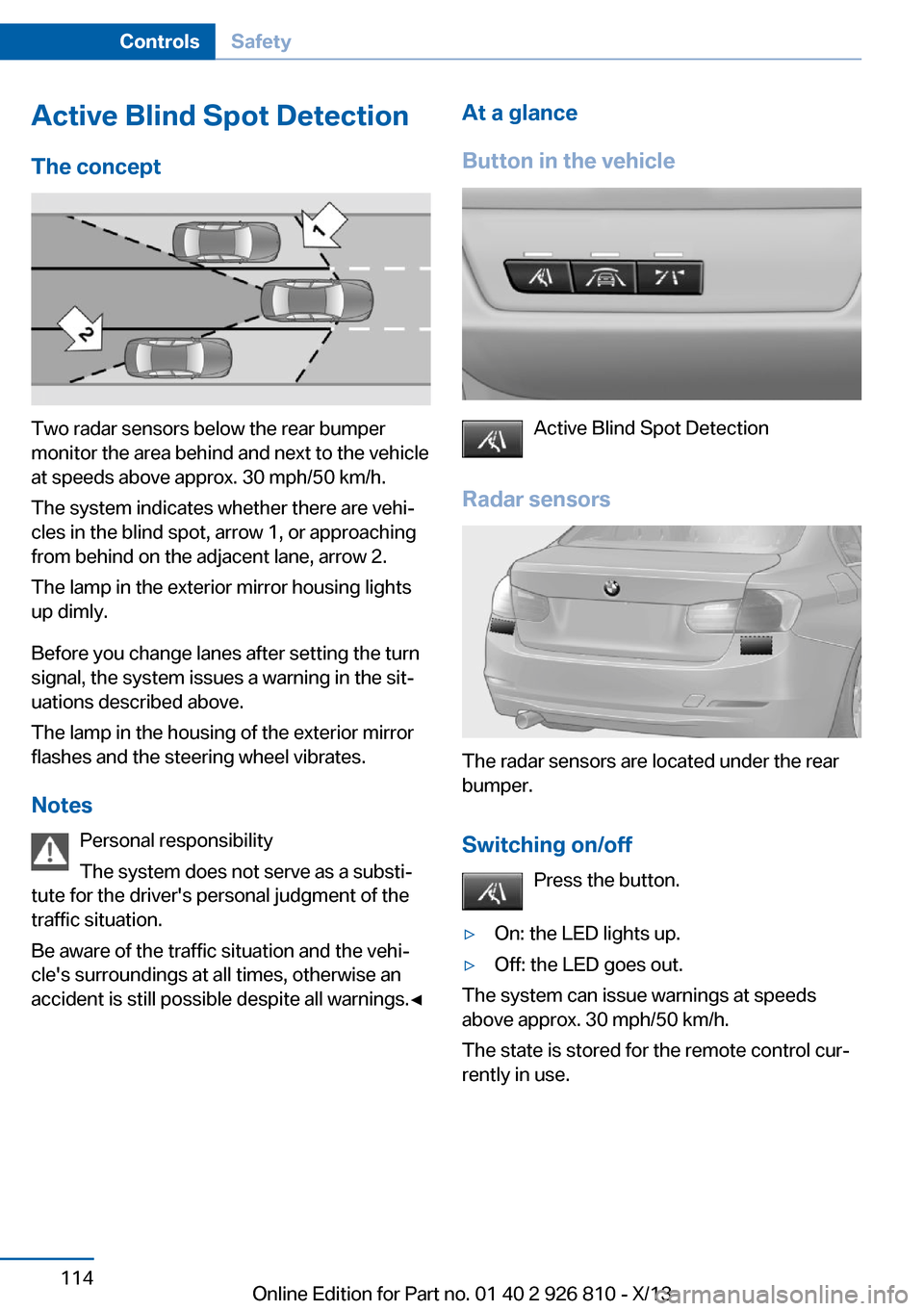
Active Blind Spot Detection
The concept
Two radar sensors below the rear bumper
monitor the area behind and next to the vehicle
at speeds above approx. 30 mph/50 km/h.
The system indicates whether there are vehi‚Äź
cles in the blind spot, arrow 1, or approaching
from behind on the adjacent lane, arrow 2.
The lamp in the exterior mirror housing lights
up dimly.
Before you change lanes after setting the turn
signal, the system issues a warning in the sit‚Äź
uations described above.
The lamp in the housing of the exterior mirror
flashes and the steering wheel vibrates.
Notes Personal responsibility
The system does not serve as a substi‚Äź
tute for the driver's personal judgment of the
traffic situation.
Be aware of the traffic situation and the vehi‚Äź
cle's surroundings at all times, otherwise an
accident is still possible despite all warnings.‚óÄ
At a glance
Button in the vehicle
Active Blind Spot Detection
Radar sensors
The radar sensors are located under the rear
bumper.
Switching on/off Press the button.
‚Ė∑On: the LED lights up.‚Ė∑Off: the LED goes out.
The system can issue warnings at speeds
above approx. 30 mph/50 km/h.
The state is stored for the remote control cur‚Äź
rently in use.
Seite 114ControlsSafety114
Online Edition for Part no. 01 40 2 926 810 - X/13
Page 126 of 248
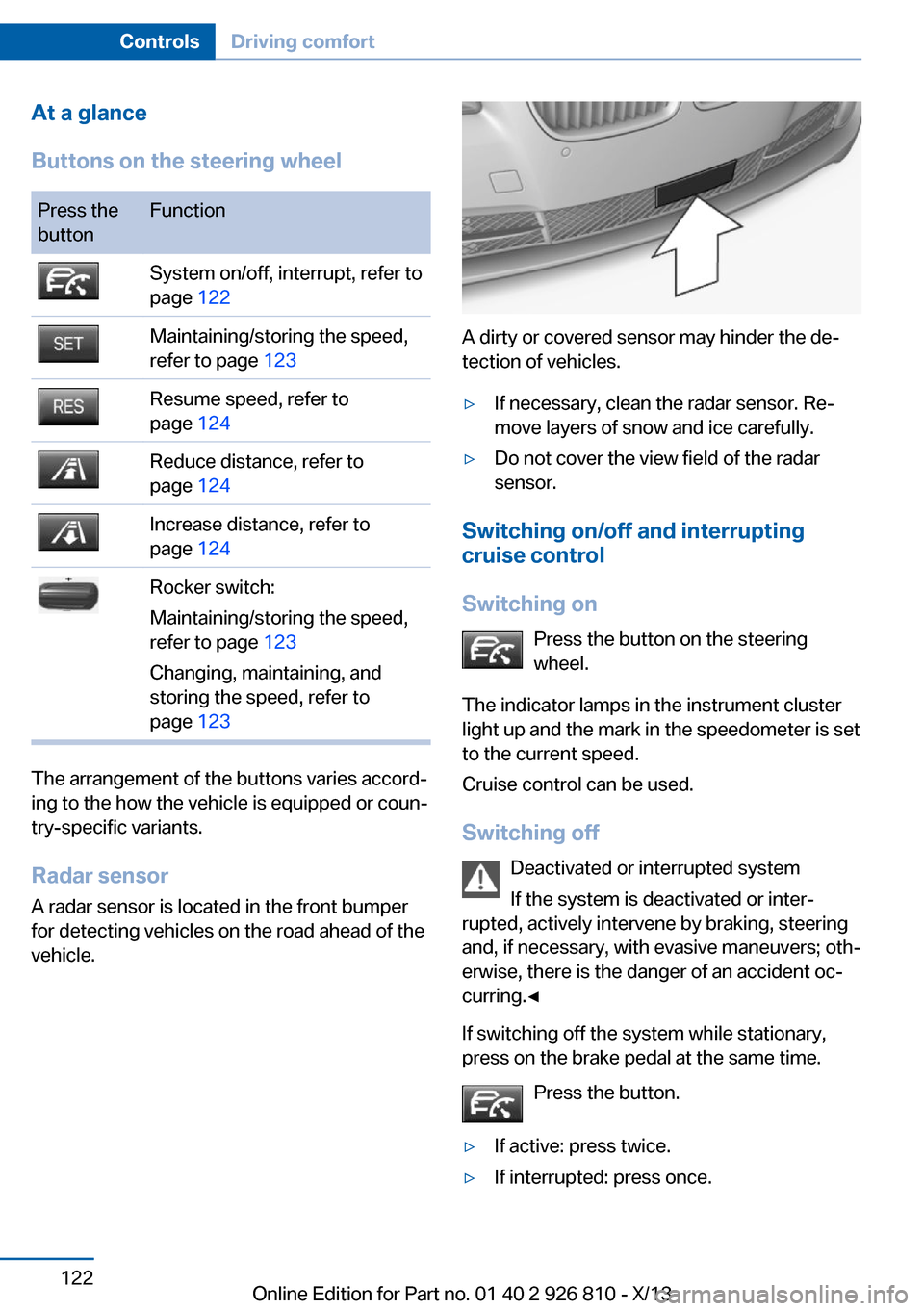
At a glance
Buttons on the steering wheelPress the
buttonFunctionSystem on/off, interrupt, refer to
page 122Maintaining/storing the speed,
refer to page 123Resume speed, refer to
page 124Reduce distance, refer to
page 124Increase distance, refer to
page 124Rocker switch:
Maintaining/storing the speed,
refer to page 123
Changing, maintaining, and
storing the speed, refer to
page 123
The arrangement of the buttons varies accord‚Äź
ing to the how the vehicle is equipped or coun‚Äź
try-specific variants.
Radar sensor
A radar sensor is located in the front bumper
for detecting vehicles on the road ahead of the
vehicle.
A dirty or covered sensor may hinder the de‚Äź
tection of vehicles.
‚Ė∑If necessary, clean the radar sensor. Re‚Äź
move layers of snow and ice carefully.‚Ė∑Do not cover the view field of the radar
sensor.
Switching on/off and interrupting cruise control
Switching on Press the button on the steering
wheel.
The indicator lamps in the instrument cluster
light up and the mark in the speedometer is set
to the current speed.
Cruise control can be used.
Switching off Deactivated or interrupted system
If the system is deactivated or inter‚Äź
rupted, actively intervene by braking, steering
and, if necessary, with evasive maneuvers; oth‚Äź
erwise, there is the danger of an accident oc‚Äź
curring.‚óÄ
If switching off the system while stationary,
press on the brake pedal at the same time.
Press the button.
‚Ė∑If active: press twice.‚Ė∑If interrupted: press once.Seite 122ControlsDriving comfort122
Online Edition for Part no. 01 40 2 926 810 - X/13
Page 128 of 248
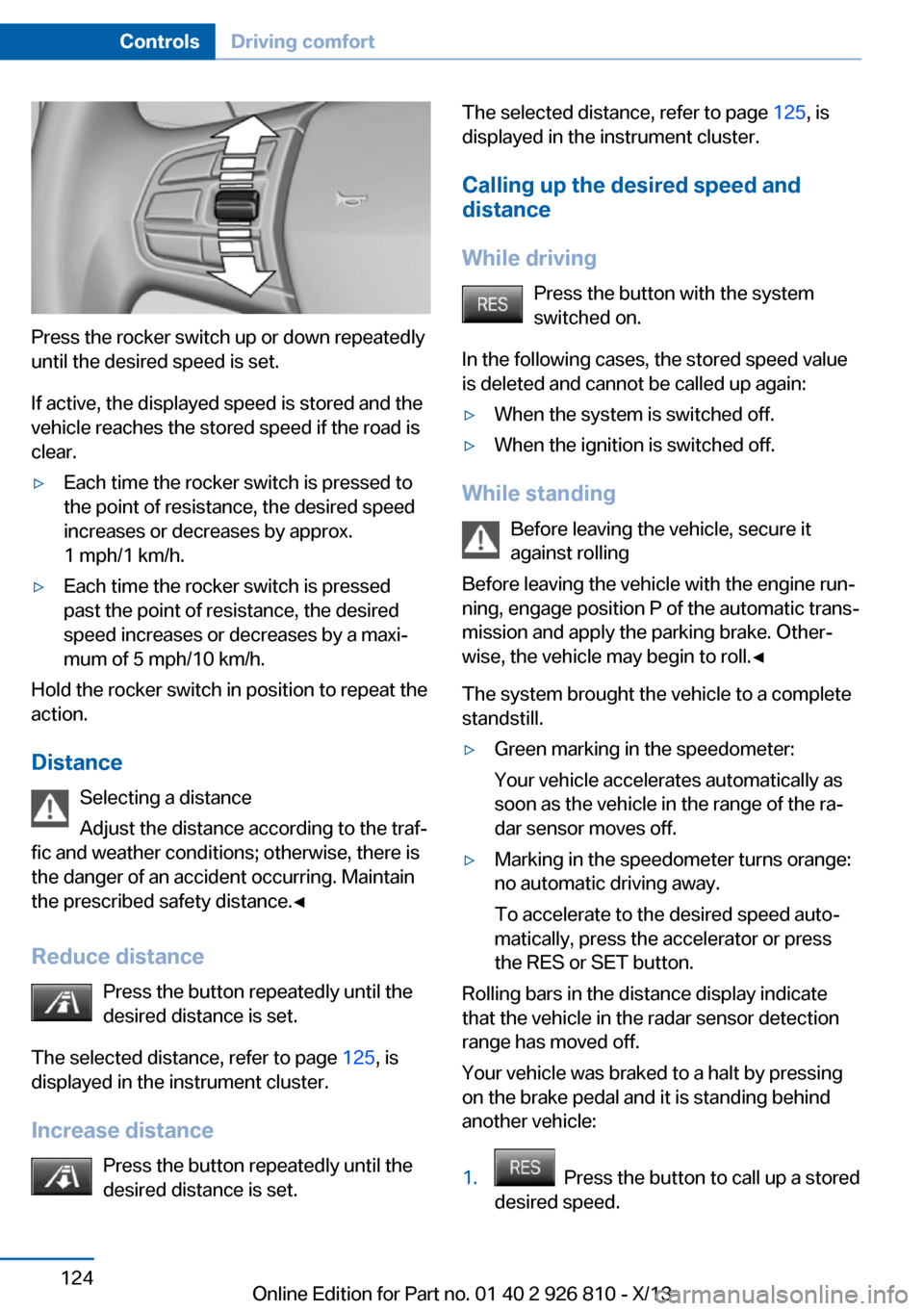
Press the rocker switch up or down repeatedly
until the desired speed is set.
If active, the displayed speed is stored and the
vehicle reaches the stored speed if the road is
clear.
‚Ė∑Each time the rocker switch is pressed to
the point of resistance, the desired speed
increases or decreases by approx.
1 mph/1 km/h.‚Ė∑Each time the rocker switch is pressed
past the point of resistance, the desired
speed increases or decreases by a maxi‚Äź
mum of 5 mph/10 km/h.
Hold the rocker switch in position to repeat the
action.
Distance Selecting a distance
Adjust the distance according to the traf‚Äź
fic and weather conditions; otherwise, there is
the danger of an accident occurring. Maintain
the prescribed safety distance.‚óÄ
Reduce distance Press the button repeatedly until the
desired distance is set.
The selected distance, refer to page 125, is
displayed in the instrument cluster.
Increase distance Press the button repeatedly until the
desired distance is set.
The selected distance, refer to page 125, is
displayed in the instrument cluster.
Calling up the desired speed and
distance
While driving Press the button with the system
switched on.
In the following cases, the stored speed value
is deleted and cannot be called up again:‚Ė∑When the system is switched off.‚Ė∑When the ignition is switched off.
While standing
Before leaving the vehicle, secure it
against rolling
Before leaving the vehicle with the engine run‚Äź
ning, engage position P of the automatic trans‚Äź
mission and apply the parking brake. Other‚Äź
wise, the vehicle may begin to roll.‚óÄ
The system brought the vehicle to a complete
standstill.
‚Ė∑Green marking in the speedometer:
Your vehicle accelerates automatically as
soon as the vehicle in the range of the ra‚Äź
dar sensor moves off.‚Ė∑Marking in the speedometer turns orange:
no automatic driving away.
To accelerate to the desired speed auto‚Äź
matically, press the accelerator or press
the RES or SET button.
Rolling bars in the distance display indicate
that the vehicle in the radar sensor detection
range has moved off.
Your vehicle was braked to a halt by pressing
on the brake pedal and it is standing behind
another vehicle:
1. Press the button to call up a stored
desired speed.
Seite 124ControlsDriving comfort124
Online Edition for Part no. 01 40 2 926 810 - X/13
Page 130 of 248
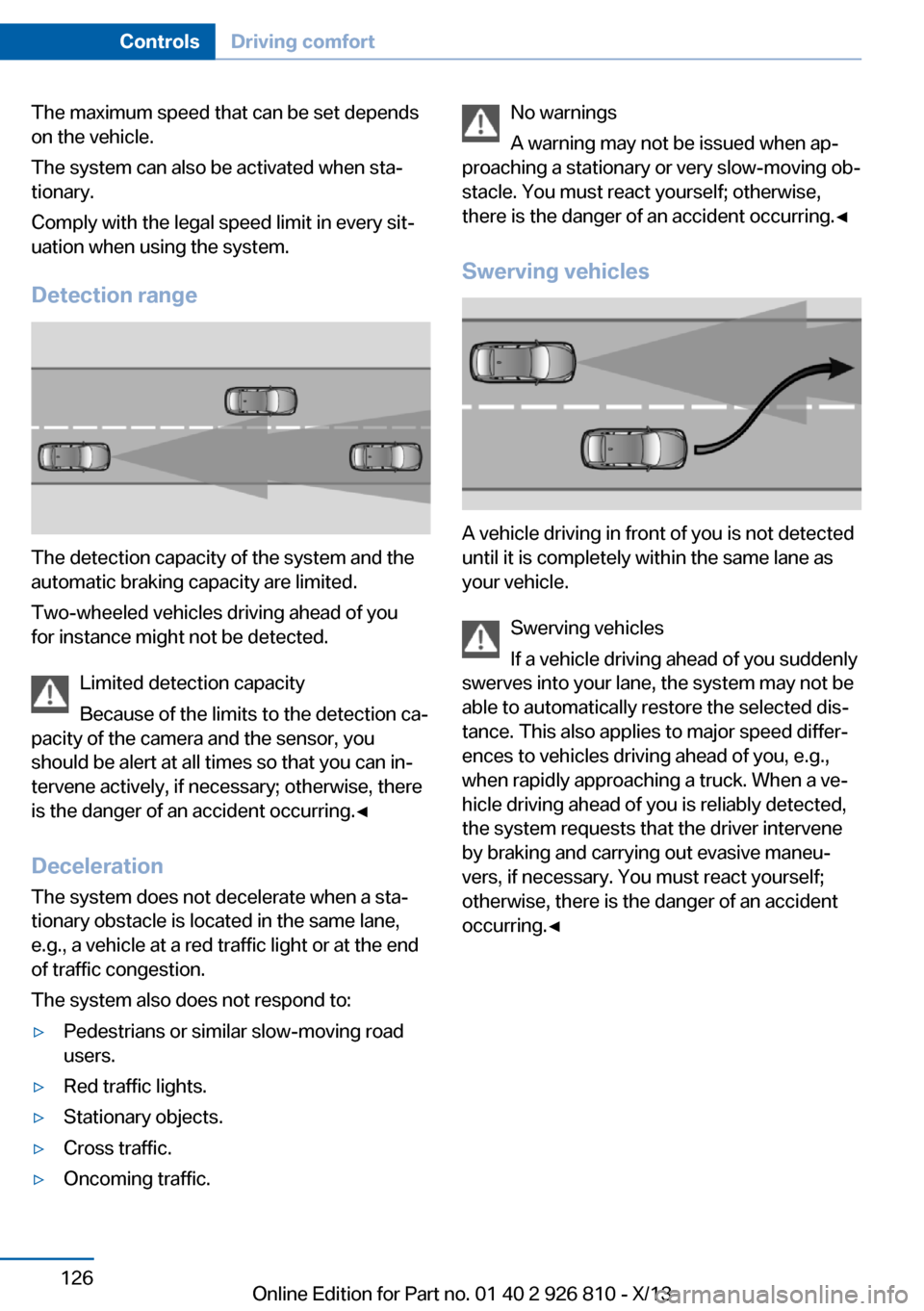
The maximum speed that can be set depends
on the vehicle.
The system can also be activated when sta‚Äź
tionary.
Comply with the legal speed limit in every sit‚Äź
uation when using the system.
Detection range
The detection capacity of the system and the
automatic braking capacity are limited.
Two-wheeled vehicles driving ahead of you
for instance might not be detected.
Limited detection capacity
Because of the limits to the detection ca‚Äź
pacity of the camera and the sensor, you
should be alert at all times so that you can in‚Äź
tervene actively, if necessary; otherwise, there
is the danger of an accident occurring.‚óÄ
Deceleration
The system does not decelerate when a sta‚Äź
tionary obstacle is located in the same lane,
e.g., a vehicle at a red traffic light or at the end
of traffic congestion.
The system also does not respond to:
‚Ė∑Pedestrians or similar slow-moving road
users.‚Ė∑Red traffic lights.‚Ė∑Stationary objects.‚Ė∑Cross traffic.‚Ė∑Oncoming traffic.No warnings
A warning may not be issued when ap‚Äź
proaching a stationary or very slow-moving ob‚Äź
stacle. You must react yourself; otherwise,
there is the danger of an accident occurring.‚óÄ
Swerving vehicles
A vehicle driving in front of you is not detected
until it is completely within the same lane as
your vehicle.
Swerving vehicles
If a vehicle driving ahead of you suddenly
swerves into your lane, the system may not be
able to automatically restore the selected dis‚Äź
tance. This also applies to major speed differ‚Äź
ences to vehicles driving ahead of you, e.g.,
when rapidly approaching a truck. When a ve‚Äź
hicle driving ahead of you is reliably detected,
the system requests that the driver intervene
by braking and carrying out evasive maneu‚Äź
vers, if necessary. You must react yourself;
otherwise, there is the danger of an accident
occurring.‚óÄ
Seite 126ControlsDriving comfort126
Online Edition for Part no. 01 40 2 926 810 - X/13
Page 131 of 248
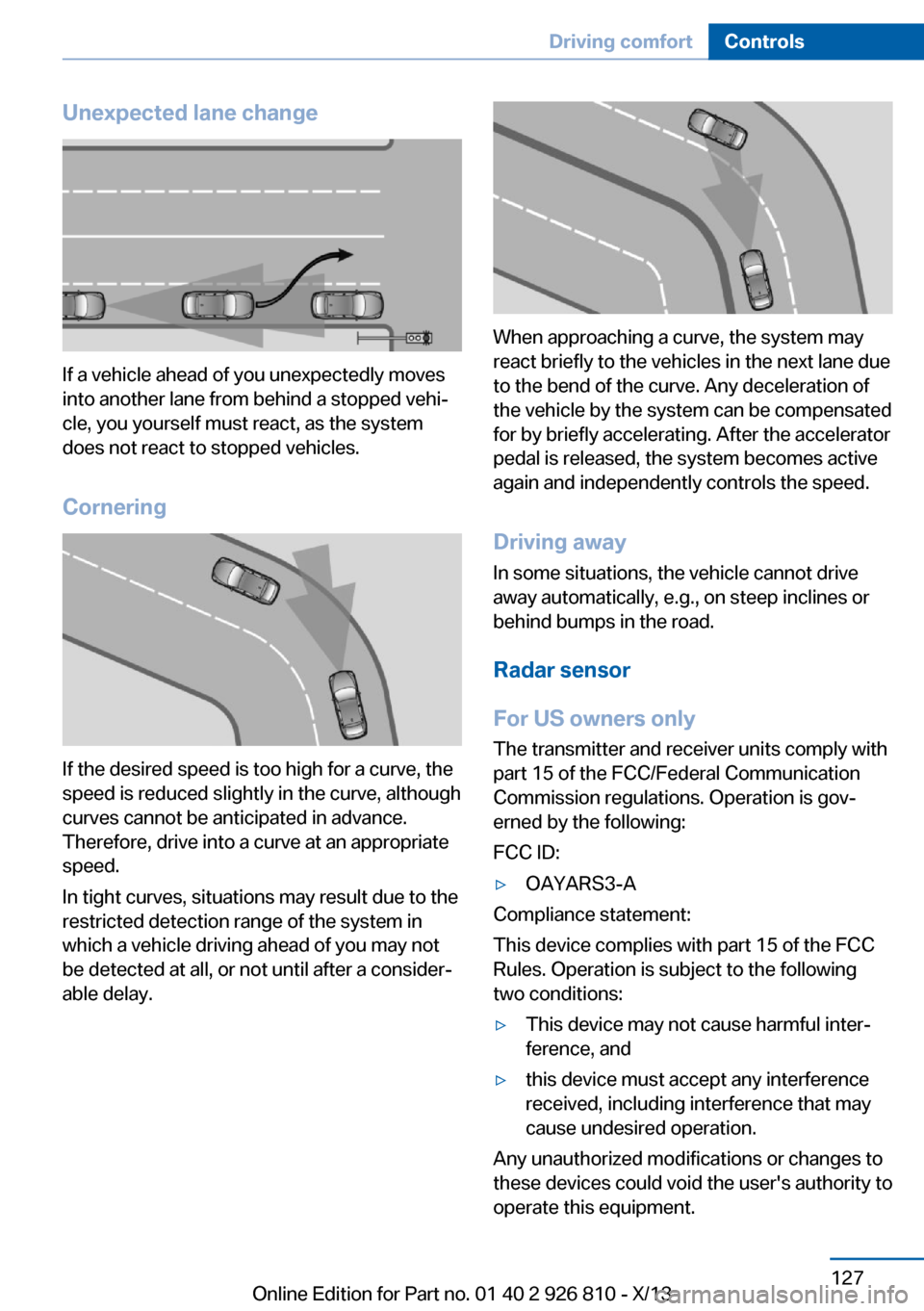
Unexpected lane change
If a vehicle ahead of you unexpectedly moves
into another lane from behind a stopped vehi‚Äź
cle, you yourself must react, as the system
does not react to stopped vehicles.
Cornering
If the desired speed is too high for a curve, the
speed is reduced slightly in the curve, although
curves cannot be anticipated in advance.
Therefore, drive into a curve at an appropriate
speed.
In tight curves, situations may result due to the
restricted detection range of the system in
which a vehicle driving ahead of you may not
be detected at all, or not until after a consider‚Äź
able delay.
When approaching a curve, the system may
react briefly to the vehicles in the next lane due
to the bend of the curve. Any deceleration of
the vehicle by the system can be compensated
for by briefly accelerating. After the accelerator
pedal is released, the system becomes active
again and independently controls the speed.
Driving away In some situations, the vehicle cannot drive
away automatically, e.g., on steep inclines or
behind bumps in the road.
Radar sensor
For US owners only
The transmitter and receiver units comply with
part 15 of the FCC/Federal Communication
Commission regulations. Operation is gov‚Äź
erned by the following:
FCC ID:
‚Ė∑OAYARS3-A
Compliance statement:
This device complies with part 15 of the FCC
Rules. Operation is subject to the following
two conditions:
‚Ė∑This device may not cause harmful inter‚Äź
ference, and‚Ė∑this device must accept any interference
received, including interference that may
cause undesired operation.
Any unauthorized modifications or changes to
these devices could void the user's authority to
operate this equipment.
Seite 127Driving comfortControls127
Online Edition for Part no. 01 40 2 926 810 - X/13
Page 132 of 248
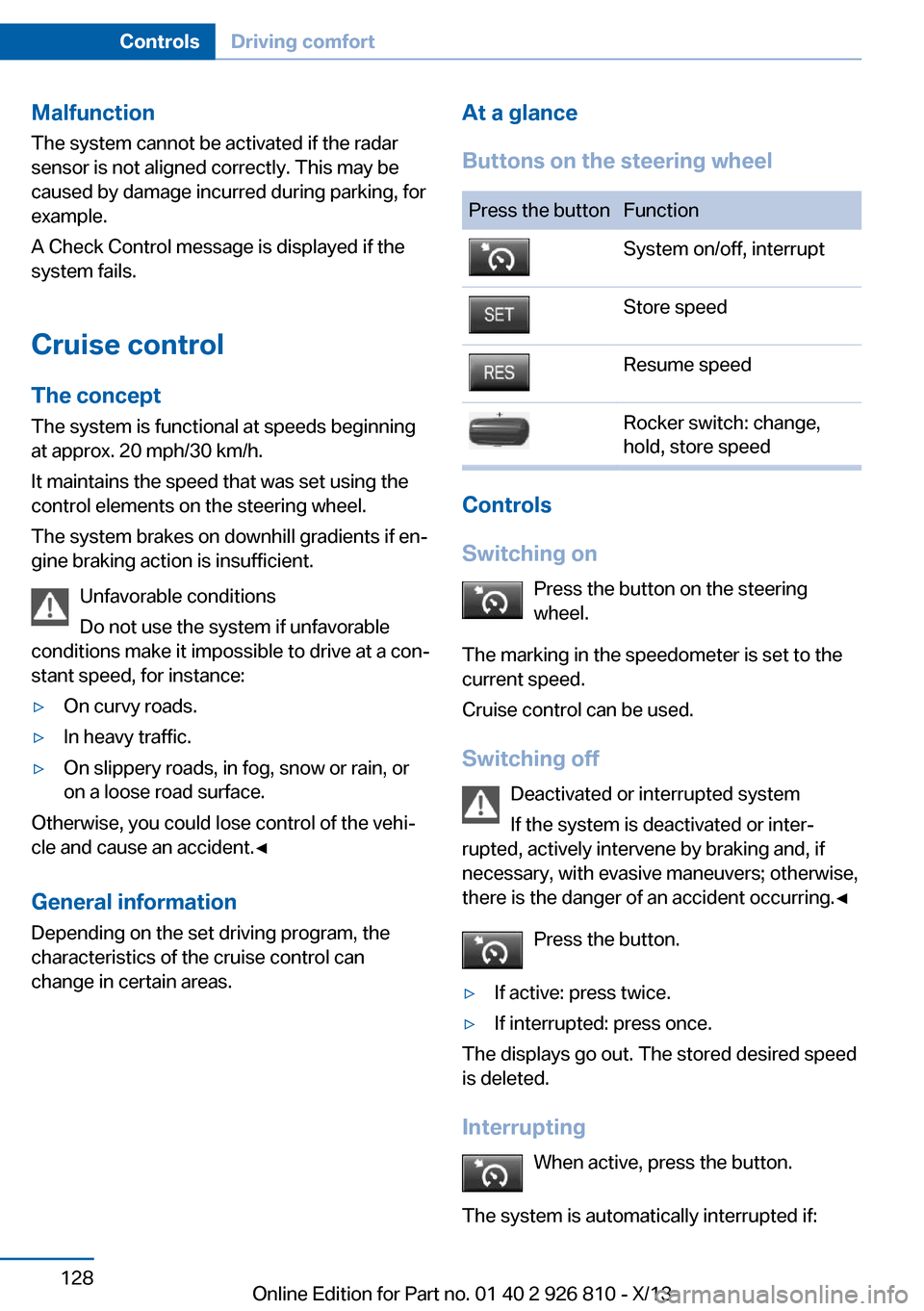
Malfunction
The system cannot be activated if the radar
sensor is not aligned correctly. This may be
caused by damage incurred during parking, for
example.
A Check Control message is displayed if the
system fails.
Cruise control
The concept The system is functional at speeds beginning
at approx. 20 mph/30 km/h.
It maintains the speed that was set using the
control elements on the steering wheel.
The system brakes on downhill gradients if en‚Äź
gine braking action is insufficient.
Unfavorable conditions
Do not use the system if unfavorable
conditions make it impossible to drive at a con‚Äź
stant speed, for instance:‚Ė∑On curvy roads.‚Ė∑In heavy traffic.‚Ė∑On slippery roads, in fog, snow or rain, or
on a loose road surface.
Otherwise, you could lose control of the vehi‚Äź
cle and cause an accident.‚óÄ
General information
Depending on the set driving program, the
characteristics of the cruise control can
change in certain areas.
At a glance
Buttons on the steering wheelPress the buttonFunctionSystem on/off, interruptStore speedResume speedRocker switch: change,
hold, store speed
Controls
Switching on Press the button on the steering
wheel.
The marking in the speedometer is set to the
current speed.
Cruise control can be used.
Switching off Deactivated or interrupted system
If the system is deactivated or inter‚Äź
rupted, actively intervene by braking and, if
necessary, with evasive maneuvers; otherwise,
there is the danger of an accident occurring.‚óÄ
Press the button.
‚Ė∑If active: press twice.‚Ė∑If interrupted: press once.
The displays go out. The stored desired speed
is deleted.
Interrupting When active, press the button.
The system is automatically interrupted if:
Seite 128ControlsDriving comfort128
Online Edition for Part no. 01 40 2 926 810 - X/13
Page 134 of 248
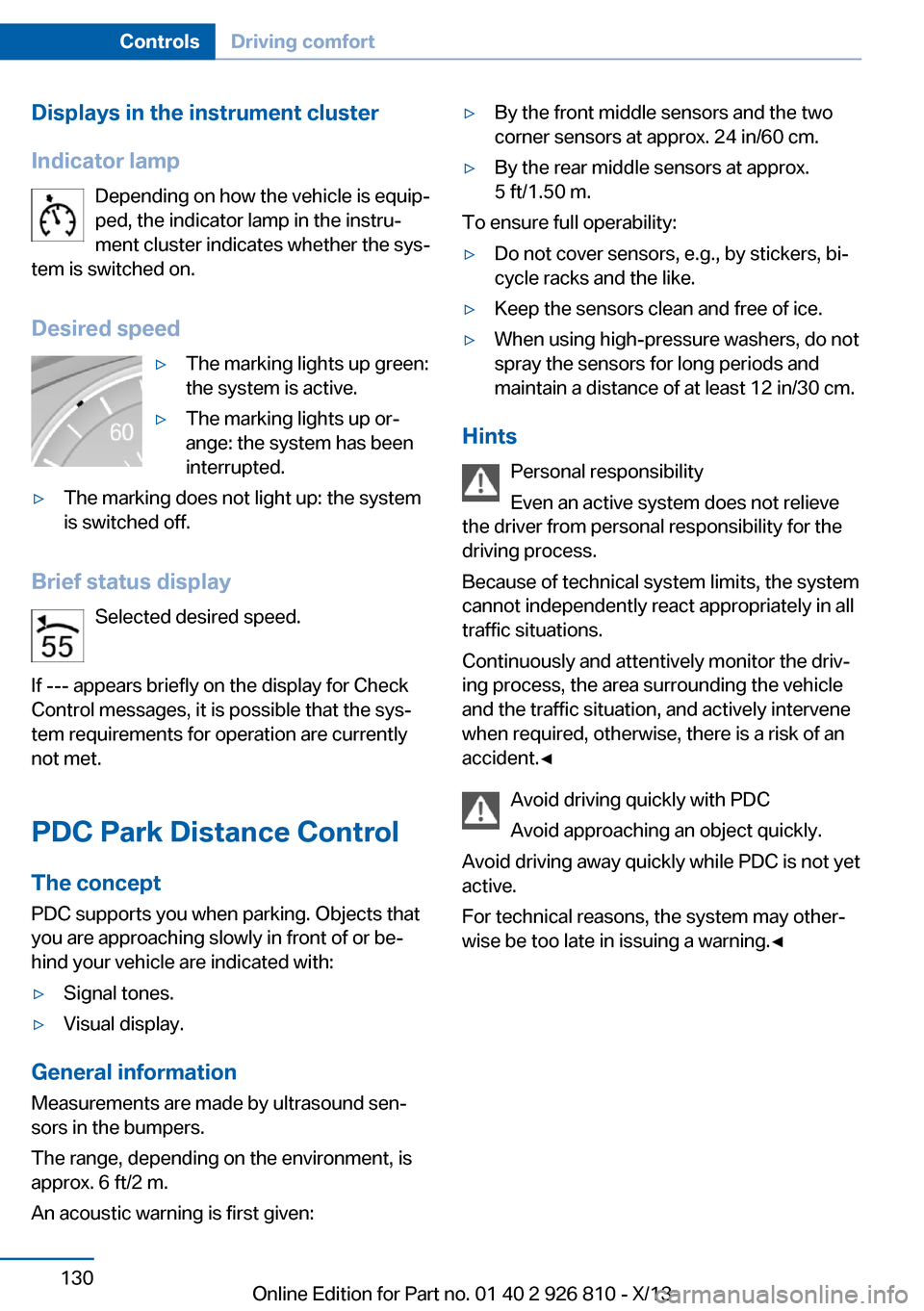
Displays in the instrument cluster
Indicator lamp Depending on how the vehicle is equip‚Äź
ped, the indicator lamp in the instru‚Äź
ment cluster indicates whether the sys‚Äź
tem is switched on.
Desired speed‚Ė∑The marking lights up green:
the system is active.‚Ė∑The marking lights up or‚Äź
ange: the system has been
interrupted.‚Ė∑The marking does not light up: the system
is switched off.
Brief status display
Selected desired speed.
If --- appears briefly on the display for Check
Control messages, it is possible that the sys‚Äź
tem requirements for operation are currently
not met.
PDC Park Distance Control
The concept PDC supports you when parking. Objects that
you are approaching slowly in front of or be‚Äź
hind your vehicle are indicated with:
‚Ė∑Signal tones.‚Ė∑Visual display.
General information
Measurements are made by ultrasound sen‚Äź
sors in the bumpers.
The range, depending on the environment, is
approx. 6 ft/2 m.
An acoustic warning is first given:
‚Ė∑By the front middle sensors and the two
corner sensors at approx. 24 in/60 cm.‚Ė∑By the rear middle sensors at approx.
5 ft/1.50 m.
To ensure full operability:
‚Ė∑Do not cover sensors, e.g., by stickers, bi‚Äź
cycle racks and the like.‚Ė∑Keep the sensors clean and free of ice.‚Ė∑When using high-pressure washers, do not
spray the sensors for long periods and
maintain a distance of at least 12 in/30 cm.
Hints
Personal responsibility
Even an active system does not relieve
the driver from personal responsibility for the
driving process.
Because of technical system limits, the system
cannot independently react appropriately in all
traffic situations.
Continuously and attentively monitor the driv‚Äź
ing process, the area surrounding the vehicle
and the traffic situation, and actively intervene
when required, otherwise, there is a risk of an
accident.‚óÄ
Avoid driving quickly with PDC
Avoid approaching an object quickly.
Avoid driving away quickly while PDC is not yet
active.
For technical reasons, the system may other‚Äź
wise be too late in issuing a warning.‚óÄ
Seite 130ControlsDriving comfort130
Online Edition for Part no. 01 40 2 926 810 - X/13
Page 135 of 248
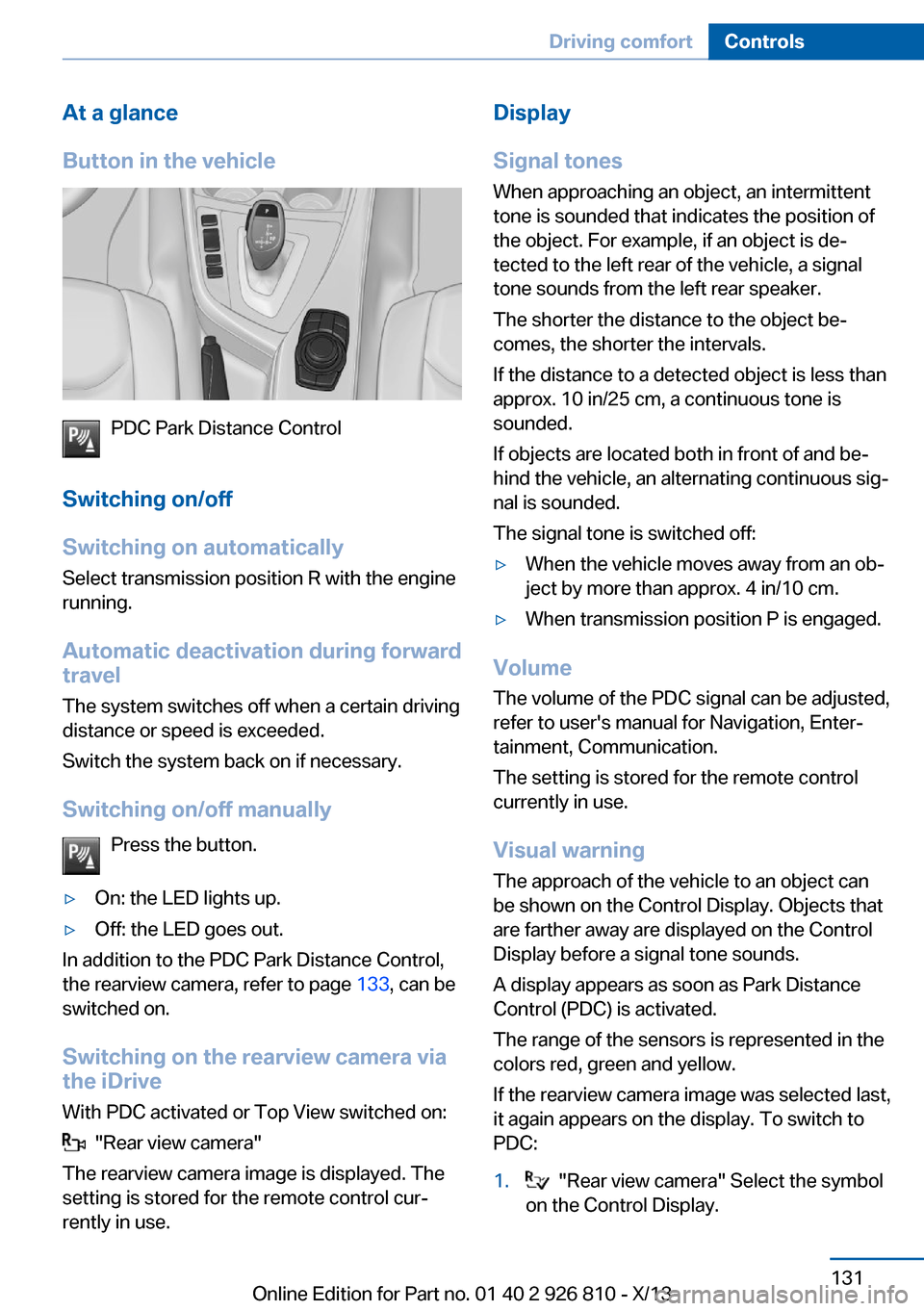
At a glance
Button in the vehicle
PDC Park Distance Control
Switching on/off
Switching on automatically Select transmission position R with the engine
running.
Automatic deactivation during forward
travel
The system switches off when a certain driving
distance or speed is exceeded.
Switch the system back on if necessary.
Switching on/off manually Press the button.
‚Ė∑On: the LED lights up.‚Ė∑Off: the LED goes out.
In addition to the PDC Park Distance Control,
the rearview camera, refer to page 133, can be
switched on.
Switching on the rearview camera viathe iDrive
With PDC activated or Top View switched on:
"Rear view camera"
The rearview camera image is displayed. The
setting is stored for the remote control cur‚Äź
rently in use.
Display
Signal tones When approaching an object, an intermittent
tone is sounded that indicates the position of
the object. For example, if an object is de‚Äź
tected to the left rear of the vehicle, a signal
tone sounds from the left rear speaker.
The shorter the distance to the object be‚Äź
comes, the shorter the intervals.
If the distance to a detected object is less than
approx. 10 in/25 cm, a continuous tone is
sounded.
If objects are located both in front of and be‚Äź
hind the vehicle, an alternating continuous sig‚Äź
nal is sounded.
The signal tone is switched off:‚Ė∑When the vehicle moves away from an ob‚Äź
ject by more than approx. 4 in/10 cm.‚Ė∑When transmission position P is engaged.
Volume
The volume of the PDC signal can be adjusted,
refer to user's manual for Navigation, Enter‚Äź
tainment, Communication.
The setting is stored for the remote control
currently in use.
Visual warning
The approach of the vehicle to an object can
be shown on the Control Display. Objects that
are farther away are displayed on the Control
Display before a signal tone sounds.
A display appears as soon as Park Distance
Control (PDC) is activated.
The range of the sensors is represented in the
colors red, green and yellow.
If the rearview camera image was selected last,
it again appears on the display. To switch to
PDC:
1. "Rear view camera" Select the symbol
on the Control Display.Seite 131Driving comfortControls131
Online Edition for Part no. 01 40 2 926 810 - X/13